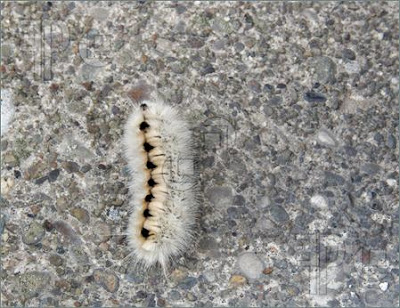The hickory tussock moth begins its life as a white caterpillar. It is not a fully white caterpillar, however, as it has an attractive design of black tufts along the middle of the back, with black spots down the sides of its body and a black head.
The hairs on the caterpillar are long and bristle-like and spread out in tufts down the sides. Two long, sharp, black pencil-like hairs protrude near the front and rear of the creature, and these hairs are connected to poison glands, which excrete venom on contact.
Contact with the venom does not generally cause too much of a problem. A nettle or poison ivy-type rash often occurs, which can range from mild with slight reddening of the skin, to burning, swelling and pain, none of which should keep you away from your gardening duties for too long. Hypersensitive individuals may, of course, experience more severe symptoms that could include swelling and nausea. Washing the infected area with soap and water, taking antihistamines, or using ammonia, calamine lotion, or an ice pack can help to alleviate most minor symptoms fairly quickly. People who do experience more severe reactions, however, should seek expert medical advice as soon as possible.
The eggs are laid in large groups on the underside of leaves, and the caterpillars are commonly seen from around June to September. Hickory moth caterpillars, like most caterpillars, have rather insatiable appetites, and can grow to around 1.5 inches (3.8 cms) in length. They are very partial to nut trees, such as pecan, hickory, and walnut, but will also eat a variety of other things, such as ash, oak, willow, apple, elm, raspberry, corn leaves, vegetable plants, and various shrubs.
Although the hickory tussock moth caterpillar can cause destruction at times, such as defoliating individual trees, the problem doesn't usually escalate to the point that they cause too much long-term damage. There are, of course, a variety of ways of exercising caterpillar control, which will help to slow these greedy individuals down and prevent them from attacking your prize plants and trees. The best way to do this is in an environmentally friendly manner, so that no nasty chemicals are introduced unnecessarily into the garden.
Pesticides should only ever be used as a last resort, and great care should always be taken when using them. Always read the label instructions properly, heed any warnings, and wear suitable protective clothing, gloves and safety glasses at all times.
First, you can try picking the caterpillars off the area, but obviously this can be tricky due to their stinging hairs. The best way to perform the task, therefore, is to use a pair of protective gloves. Another way of removing these pests from your garden is to introduce and encourage a host of predatory animals, such as lizards, frogs, wasps, and birds. Although some of these predators may not touch a poisonous caterpillar, others will, and some may even eat the eggs before they get chance to hatch.
Finally, practicing good organic gardening methods, such as exercising crop rotation and not planting your vegetables in rows, will help to ensure that all your plants are strong and healthy and able to fight off unwanted caterpillars.


i thought i saw one of these i picked it up but no rash, i cant remeber what it looked like cause now it is in a cocoon. i hope it wasnt, could you maybe post what a butterfly of it is? im just a kid by the way.
ReplyDeleteHi. Sorry no one replied to you. Go to the link below and you can see some pics of the moths they turn into. They look
ReplyDeletereal nice. Some are kinda cute. 🙂
https://www.butterfliesandmoths.org/species/Lophocampa-caryae
I find it fascinating how nature balances itself with both harmful and beneficial creatures.
ReplyDelete